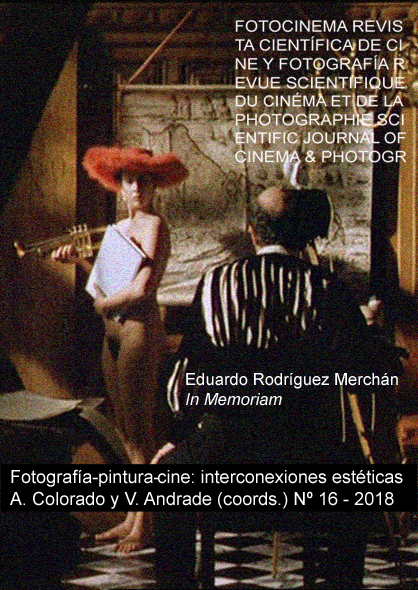Photography-Painting-Cinema: Aesthetic Interconexions
DOI:
https://doi.org/10.24310/Fotocinema.2018.v0i16.4084Keywords:
Cinema, Photography, Painting, Contemporary Art, Avant-garde, Visual Culture, Interrelations, SynergiesAbstract
First, it was photography, with its chrono-photographic derivations, and then cinema came. Thy impacted directly or indirectly on plastic images, pushing them –and sometimes forcing them – to look for new tracks. These new media felt the temptation, from the beginning, of drawing upon the History of pictorial to imbue themselves with the language of Art, a characteristics many times denied to them. This way, a permanent contamination has happened, together with a dialogue between plastic and technological image in modern times.
It is not possible to understand Impressionism first and Cubism or Futurism not taking into account photography and then the cinema, or even pop art not considering the influence of mass media. It is just as impossible to understand the process of dematerialization of art in the last avant-garde movements not realizing that these actions are supported by photographic and moving images, being their last footprints actions like happenings, performances the Land-Art or Body-Art.
Many filmmakers have felt the need of approaching painting to obtain inspiration from it or to narrate the life of its creators. Conversely, many plastic artists have considered photography a total artwork that allowed them to play with movement and time. They are the painting-filmmaker who in many instances could express themselves in either medium.
Downloads
Metrics
References
Aumont, J. (1996). El ojo interminable. Cine y pintura. Barcelona: Paidós.
Bellour, R. (Dir.) (1990). Cinéma et peinture, approches. Paris: P.U.F.
Bonitzer, P. (2007). Desencuadres. Cine y pintura. Buenos Aires: Santiago Arcos Ed.
Borau, J. L. (2003). La pintura en el cine. El cine en la pintura. Madrid: Ocho y medio.
Colorado Castellary, A. (2016). Ojo móvil, dinamismo y montaje. El influjo cinematográfico en las primeras vanguardias artísticas. Fotocinema. Revista científica de cine y fotografía, 13, pp. 179-203. Disponible: http://www.revistas.uma.es/index.php/fotocinema/
Costa, A. (1991). Cinema e pittura. Torino: Loescher.
Dalí, S. (1927). La fotografía, pura creació de l’esperit. L’Amic de les Arts, 18, pp. 90-91.
Debray, R. (1994). Vida y muerte de la imagen. Historia de la mirada en Occidente. Barcelona: Paidós.
Francastel, P. (1990). Arte y técnica en los siglos XIX y XX. Madrid: Debate.
Huyssen, A. (2002). La dialéctica oculta: vanguardia-tecnología-cultura de masas. En Después de la gran división. Modernismo, cultura de masas, posmodernismo. Buenos Aires: Adriana Hidalgo Ed.
Lieser, W. (2009). Arte digital. Colonia: H.F.Hullmann (Digital Art, 2008Koll: Tandem Verlag).
Martin, S. (2007). Videoarte. Colonia: Taschen.
Martín Prada, J. (2012). Prácticas artísticas e Internet en la época de las redes sociales. Madrid: Cátedra.
Moholy-Nagy, L. (2005). Pintura, fotografía, cine. Barcelona: Gustavo Gili.
Ortiz, Á. y Piqueras M. J. (1995). La pintura en el cine, Cuestiones de representación visual. Barcelona: Paidós.
Ramírez, J. A. (2009). El objeto y el aura. (Des)orden visual del arte moderno. Madrid: Akal.
Rush, M. (2007). Video Art. London: Thames & Hudson.
Vancheri, L. (2007). Cinéma et peinture: passajes, partages, présences.
Wands, B. (2006). Art of the digital age. London: Thames & Hudson.
Downloads
Published
How to Cite
Issue
Section
License
All contents published in Fotocinema Revista científica de cine y fotografía are protected under the Creative Commons Attribution-NonCommercial-ShareAlike 4.0 International (CC BY-NC-SA 4.0) license. All about this license is available in the following link: <http://creativecommons.org/licenses/by-nc-sa/4.0>
Users can copy, use, redistribute, share and exhibit publicly as long as:
- The original source and authorship of the material are cited (Journal, Publisher and URL of the work).
- It is not used for comercial purposes.
- The existence of the license and its especifications are mentioned.
There are two sets of authors’ rights: moral and property rights. Moral rights are perpetual prerogatives, unrenounceable, not-transferable, unalienable, imprescriptible and inembargable. According to authors’ rights legislation, Fotocinema. Revista científica de cine y fotografía recognizes and respects authors moral rights, as well as the ownership of property rights, which will be transferred to University of Malaga in open access. The property rights are referred to the benefits that are gained by the use or the dissemination of works. Fotocinema. Revista científica de cine y fotografía is published in an open access form and it is exclusively licenced by any means for doing or authorising distribution, dissemination, reproduction, , adaptation, translation or arrangement of works.
Authors are responsable for obtaining the necessary permission to use copyrighted images.













13.png)



